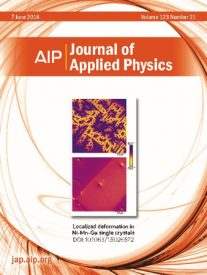
June 2018 – “Localized deformation in Ni-Mn-Ga single crystals” (DOI: 10.1063/1.5026572), a paper authored by several current and former NMDG members, was selected as the cover article for the June 21, 2018, issue of the Journal of Applied Physics (Volume 123, Number 21). The paper describes work carried out by Corey Efaw, Lance Patten, and Courtney Hollar during their time as undergraduate researchers in the NMDG at Boise State. All three are now doctoral students working on different projects in the Micron School of Materials Science and Engineering (MSMSE), highlighting the importance and broad applicability of undergraduate research experience. The research team, led by Professors Peter Müllner and Bill Knowlton, studied the nanoscale mechanical and magnetic properties of the magnetic shape memory alloy (MSMA) Ni-Mn-Ga. MSMAs are remarkable in that their size and shape can be reversibly transformed by application of magnetic fields. Conversely, by applying force (pressure) to an MSMA, one can reorient its magnetic poles.
In the current work, which was also highlighted in a recent Boise State Update, the researchers observed that the mechanical properties of Ni-Mn-Ga depend upon the relative orientation of the crystal’s easy magnetization axis (i.e., the direction in which the magnetic north pole points) by gently pushing on individual crystals of Ni-Mn-Ga with an extremely fine (100 nm) diamond tip (a technique known as nanoindention). They also discovered that following a heating/cooling cycle, the magnetic north pole could flip by 90°, going from pointing out of the surface to lying in the plane of the surface. As shown in the journal cover image below, the team was able to visualize this change by using magnetic force microscopy (MFM) to create colored maps of the sample surface showing the relative orientation of the magnetic moment.
Prof. Müllner is an internationally recognized expert in magnetic shape memory alloys, which hold promise for applications as diverse as information storage, microfluidic pumps, actuators, and sensors, while Prof. Knowlton has expertise in atomic and magnetic force microscopy (AFM and MFM) for characterizing such materials. Other NMDG team members involved in the paper included Chad Watson and lead author Dr. Paul Davis. The two are the former and current managers, respectively, of the NMDG’s Surface Science Lab, where the majority of the experimental work was performed. The insights gleaned into Ni-Mn-Ga’s magnetomechanical properties and the underlying mechanisms behind the changes seen may very well aid the development of devices that harness its intriguing properties: Müllner, Knowlton, and Watson jointly hold a patent for the use of Ni-Mn-Ga and related MSMAs in multi-state memory devices (“Multi-state Memory and Multi-Functional Devices Comprising Magnetoplastic or Magnetoelastic Materials”, US Patent No. US 8,233,314), and Prof. Müllner has founded a start-up company, Shaw Mountain Technology LLC, focused on commercial applications of the alloy.